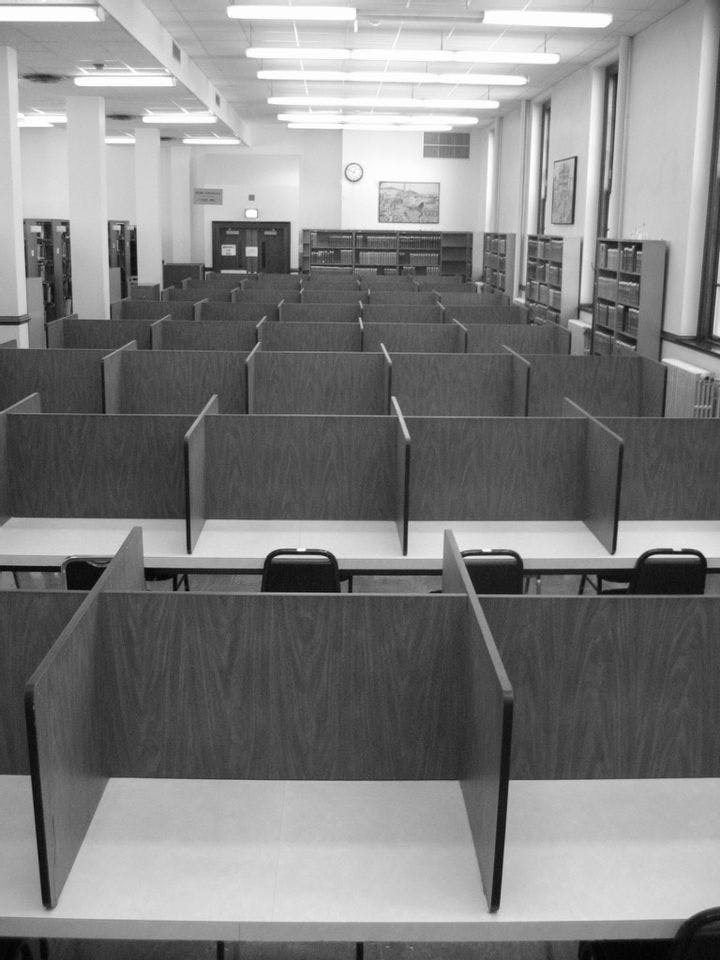Spring 2008
Annals of the Cubicle
– The Wilson Quarterly
Nothing epitomizes the modern American office economy like the flimsy, fabric-covered partitions that enclose millions of employees throughout their working lives. Odd to think that cubicles were envisioned as a way to create flexible, open offices intended to promote communication among coworkers.
If William H. Whyte were alive today to rewrite his 1956 book The Organization Man, he might well call it Cubicle Being. Nothing epitomizes the modern American office economy like the flimsy, fabric-covered partitions that enclose millions of employees throughout their working lives.
Ironically, cubicles started life as the Great Leap Forward of the white-collar world. An explosion of office jobs after 1945 had created battalions of jobholders doing new kinds of tasks—“knowledge work.” But the bullpen layout of the 1950s workplace was a “wasteland,” declared Robert Propst, an exuberant art professor hired to head the research wing of Herman Miller, one of the biggest office furniture companies in the world. “It saps vitality, blocks talent, frustrates accomplishment. It is the daily scene of unfulfilled intentions and failed effort.” Propst set to work, writes Nikil Saval, assistant editor of n + 1, to create flexible, open offices intended to promote communication among coworkers, flatten office hierarchies, foster individuality, and free what Saval calls the “ceaselessly inventive potential of the white-collar mind.”
Propst’s first design flopped when it debuted in 1965. Three years later came “Action Office II,” designed for a smaller space, featuring lighter walls, and made of disposable materials.
A tax change in the early 1960s aided the cubicles’ cause by allowing companies to write off the cost of their components after only seven years; traditional fixed-wall offices received far less favorable tax treatment. When one of Herman Miller’s rivals launched a competitive modular system, Propst’s innovation got the validation it needed. The revolution was on.
In the late 1970s and ’80s, big business suffered a crisis of profitability, Saval writes, and the toiling masses in the cubicles paid the price. Between 1990 and 1992 a total of 1.1 million white-collar workers were laid off, a greater number than their similarly discharged blue-collar counterparts. Workweeks became longer. Vacation days remained stuck at an average of 9 to 12 a year, compared with 30 for workers in Germany. The cubicle, conceived as a liberating innovation, became a symbol of “transience, arbitrariness, and insecurity.”
The cubicle revolution also made it possible for bosses to squeeze more workers into ever smaller spaces. Between 1999 and 2006, the average cubicle shrank from 90 square feet to 75. Michael Bloomberg, the current mayor of New York, allowed just four square feet to workers in the headquarters of his media empire in 1999—to increase “collaboration.”
A few tech companies began to break out of the “cube farm” trend during the dot-com boom of the 1990s. But the defectors didn't treat their workers much better. Their whimsical workplaces, with their game rooms and free food, were designed to foster creativity—and workweeks of 80 to 100 hours. It was just another iteration of the white-collar sweatshop, Saval says.
Today, cubicle refugees face grim alternatives, often working at home and paying for their own workspace as well as health care and retirement, Saval writes. Office design theorists now burble about “spaceless growth.” It’s foolish for white-collar workers to aspire merely to “graduate” from the cubicle to the corner office, Saval declares. The office landscape may change, but the real issues remain the same: pay, leisure time, job security, and the “autonomy that was promised, and perverted, by the cubicle.”
* * *
The Source: "Birth of the Office" by Nikil Saval, in n+1, Winter 2008.
Photo courtesy of Flickr/yuan2003
